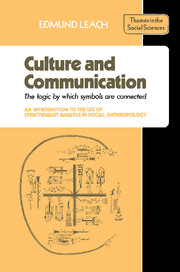 Culture and Communication
Culture and Communication Book contents
- Frontmatter
- Contents
- Culture and communication: the logic by which symbols are connected
- Introduction
- 1 Empiricists and rationalists: economic transactions and acts of communication
- 2 Problems of terminology
- 3 Objects, sense-images, concepts
- 4 Signals and indices
- 5 Transformations
- 6 Theories of magic and sorcery
- 7 The symbolic ordering of a man-made world: boundaries of social space and time
- 8 The material representation of abstract ideas: ritual condensation
- 9 Orchestral performance as a metaphor for ritual sequence
- 10 The physiological basis of sign/symbol sets
- 11 Mapping: time and space as reciprocal representations
- 12 Rank order and orientation
- 13 Examples of binary coding
- 14 Mating prescriptions and proscriptions
- 15 Logic and mytho-logic
- 16 Basic cosmology
- 17 Rites of transition (rites de passage)
- 18 The logic of sacrifice
- 19 Conclusion
- Bibliography
- Index
7 - The symbolic ordering of a man-made world: boundaries of social space and time
Published online by Cambridge University Press: 05 June 2012
- Frontmatter
- Contents
- Culture and communication: the logic by which symbols are connected
- Introduction
- 1 Empiricists and rationalists: economic transactions and acts of communication
- 2 Problems of terminology
- 3 Objects, sense-images, concepts
- 4 Signals and indices
- 5 Transformations
- 6 Theories of magic and sorcery
- 7 The symbolic ordering of a man-made world: boundaries of social space and time
- 8 The material representation of abstract ideas: ritual condensation
- 9 Orchestral performance as a metaphor for ritual sequence
- 10 The physiological basis of sign/symbol sets
- 11 Mapping: time and space as reciprocal representations
- 12 Rank order and orientation
- 13 Examples of binary coding
- 14 Mating prescriptions and proscriptions
- 15 Logic and mytho-logic
- 16 Basic cosmology
- 17 Rites of transition (rites de passage)
- 18 The logic of sacrifice
- 19 Conclusion
- Bibliography
- Index
Summary
One crucial point here is that our internal perception of the world around us is greatly influenced by the verbal categories which we use to describe it. A modern urban street scene is wholly man-made and it is only because all the things in it carry individual names, i.e. symbolic labels, that we can recognise what they are. This is true of all human culture and of all human societies. We use language to cut up the visual continuum into meaningful objects and into persons filling distinguishable roles. But we also use language to tie the component elements together again, to put things and persons in relationship to one another. As my very first example about gift giving showed (p. 6), this double function of symbolic action applies to non-verbal as well as to verbal behaviour.
Much the same point is implicit in my contextual definition of signs (p. 14). All signs, and most symbols and signals, cohere together as sets. Meanings depend upon contrast. Red and Green lights mean Stop and Go, but only when they are contrasted one against the other and in their proper setting on a public highway. We recognise a light switch for what it is because we can distinguish it by shape and location from other knobs, such as door handles and window latches, which occur in the same general context. But if we saw the same object lying on the footpath we would not expect it to function as a light switch at all.
- Type
- Chapter
- Information
- Culture and CommunicationThe Logic by which Symbols Are Connected. An Introduction to the Use of Structuralist Analysis in Social Anthropology, pp. 33 - 36Publisher: Cambridge University PressPrint publication year: 1976
- 1
- Cited by


